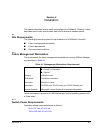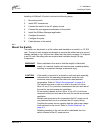
3 – Planning
Device Access
59021-04 C 3-9
Q
3.4.1
Soft Zones
Soft zoning divides the fabric for purposes of controlling discovery. Members of
the same soft zone automatically discover and communicate freely with all other
members of the same zone. The soft zone boundary is not secure; traffic across
soft zones can occur if addressed correctly. The following rules apply to soft
zones:
■ Soft zones that include members from multiple switches need not include
the ports of the inter-switch links.
■ Soft zone boundaries yield to ACL and VPF zone boundaries.
■ Soft zones can overlap; that is, a port can be a member of more than one
soft zone.
■ Membership can be defined by Fibre Channel address, port ID and domain
ID, or worldwide name.
■ Soft zoning supports all port modes.
3.4.2
Access Control List Hard Zones
Access Control List (ACL) zoning divides the fabric for purposes of controlling
discovery and inbound traffic. ACL zoning is a type of hard zoning that is
hardware enforced. This type of zoning is useful for controlling access to certain
devices without totally isolating them from the fabric. Members can communicate
with each other and transmit outside the ACL zone, but cannot receive inbound
traffic from outside the zone. The following rules apply to ACL zones:
■ The ACL zone boundary is secure against inbound traffic.
■ ACL zones can overlap; that is, a port can be a member of more than one
ACL zone.
■ ACL zones that include members from multiple switches need not include
the ports of the inter-switch links.
■ ACL zone boundaries supersede soft zone boundaries, but yield to VPF
zone boundaries.
■ Membership can be defined only by domain ID and port ID.
■ ACL zoning supports all port modes except TL_Port.


















